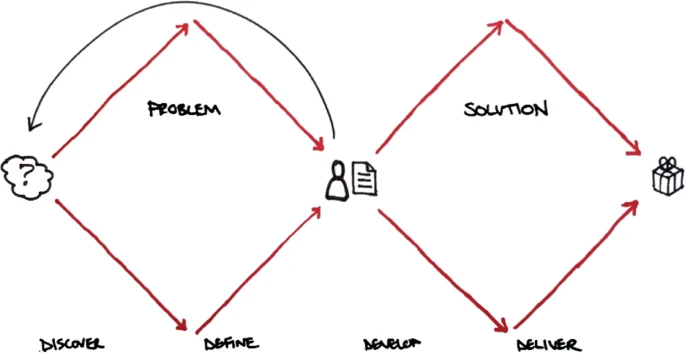12. Development Process
There are several development processes to develop a good UX. All of them are iterative, all of them start with the steps we covered in this course: user research, prototype, develop and evaluate. And, all of them start wide and narrow down for the development phase.
12.1 Double Diamond

"The first phase, Discover, is about taking as broad a look as possible, conducting research. Here empathy, openness, and a variety of research tools help the designer to observe users, to discover their goals, needs and motivations. This stage should conclude with a full immersion in the context of the challenge and a good understanding of the eventual users’ perspective. The lines of the diagram diverge and widen, symbolising an openness to information and inspiration.
The second phase, Define, is about looking at all the data you have gathered and trying to make sense of it. It is about connecting the dots, spotting patterns, hunting for insight, understanding emotions. In the second phase of the design process, discipline and order are helpful, as are tools for organising information and finding patterns in user behaviour. This is when we frame our design challenge, which often turns out different from the one we started with. With insights from the Discover and Define phases, we are able to better understand the real problems people face and frame the challenge by taking them into account, basing it no just on our assumptions. The lines of the diagram converge and meet at a key point in the process.
Then we move into Develop phase, which involves creativity, inventing solutions, experimenting, iterating and testing. This third phase of the design process, creativity and techniques stimulate thinking outside of the box. The team uses inspiration and their new understanding of the problem from previous phases of the project to create potential solutions that meet the users’ needs. The diagram again diverges and widens, symbolising an openness to create as many potential solutions as possible.
The final phase, Deliver, is about working on and refining the solution. Perseverance and accuracy, along with further testing and iterations, are useful in the fourth phase of the design process. This stage concludes with a detailed description of the solution, tested by users, combined with a specific plan for its implementation. The lines of the diagram converge again and meet at a final point in the process."1
12.2 Agile UX
For agile teams you need to discuss when and where the design should be developed, e.g. how to react to new or changed requirements?

12.3 Design Sprint
The design sprint was invented by Google and means to run a 5-day workshop to validate and sharpen a product idea before you start with the implementation. Google describes in its design sprint toolkit to use a design sprint
- At the Start of New Project to define your product or create a shared vision.
- When Time is Critical To inject speed into your development or decision-making process.
- At an Impasse, Roadblock or Fork when your product or team needs to get unstuck.
- After Uncovering New Insights To leverage new findings, data or research. In the toolkit you will find many suggested methods for each day

-
Magda Kochanowska, Weronika Rochacka Gagliardi, and with reference to Jonathan Ball. The Double Diamond Model: In Pursuit of Simplicity and Flexibility, pages 19–32. Springer International Publishing, Cham, 2022. URL: https://link.springer.com/chapter/10.1007/978-3-030-79879-6_2, doi:10.1007/978-3-030-79879-6_2. ↩
-
Jenny Pilz, Jana Deutschlaender, Jörg Thomaschewski, and Eva-Maria Schön. Integrating agile human-centered design with lean ux and scrum. In International Conference on Web Information Systems and Technologies. 10 2021. URL: https://www.researchgate.net/profile/Jenny_Pilz/publication/355734440_Integrating_Agile_Human-Centered_Design_with_Lean_UX_and_Scrum/links/617ba111a767a03c14c76066/Integrating-Agile-Human-Centered-Design-with-Lean-UX-and-Scrum.pdf, doi:10.5220/0010713800003058. ↩